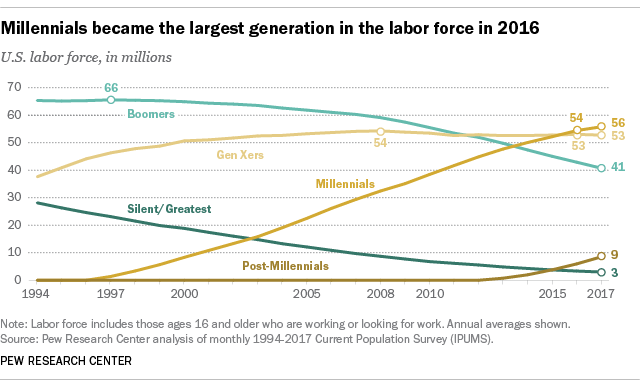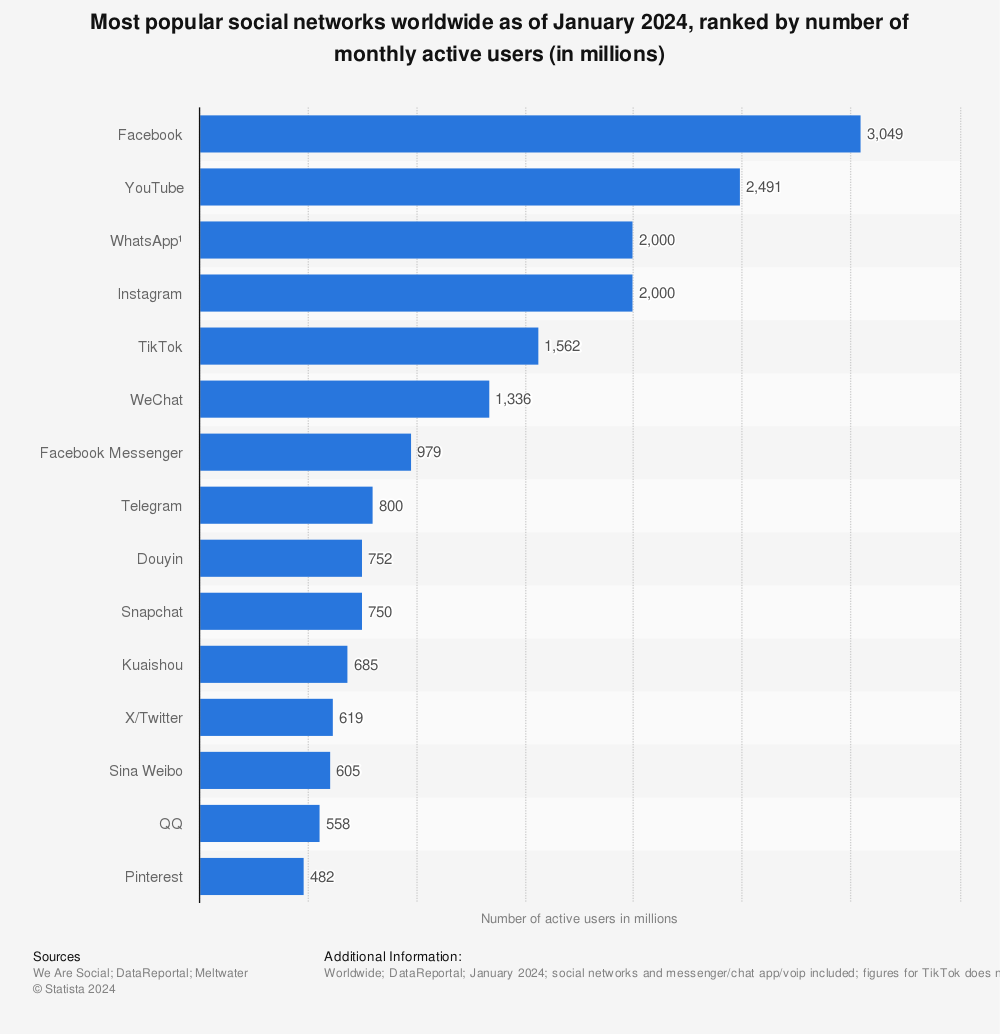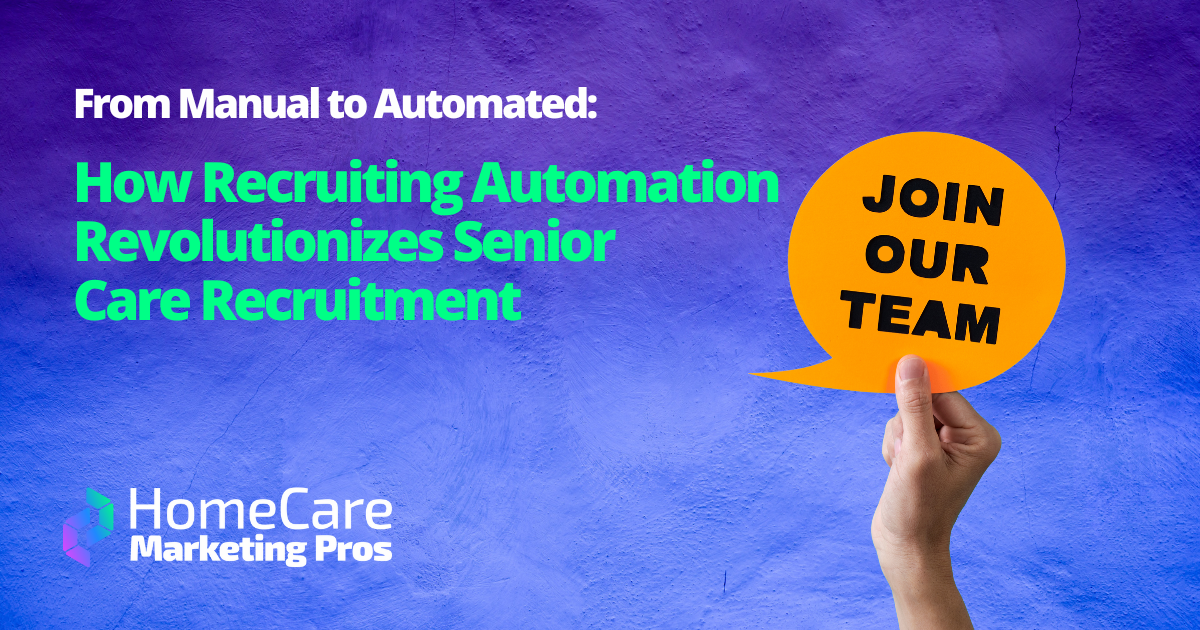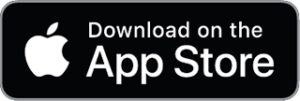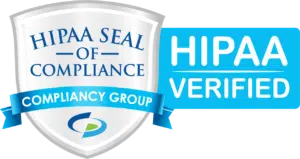The Ultimate Guide to Caregiver Recruiting
More than ever, caregivers are needed. However, caregiver recruitment may also be harder than ever. How can your agency solve this problem?

Why Is Recruiting Caregivers Such a Challenge?
According to the CDC, "The number of people 65 years old and older is expected to double between 2000 and 2030. It is expected that there will be 71 million people aged 65 years old and older when all baby boomers are at least 65 years old in 2030." And, many of these aging adults, who wish to remain in their homes, will require a part-time or full-time caregiver.
The U.S. Census Bureau projects the old-age-dependency ratio, which measures the number of elderly adults to working-age adults, to rise by 2060. This change equates to fewer caregivers or a ratio of just two-and-a-half working adults for each U.S. resident 65 or older.
The need for caregivers is rising. Still, home care agencies are struggling with low recruitment and retention rates. It's essential to identify the causes and implement a system to boost caregiver recruitment and increase the number of employees who stay within your agency.
The Overlooked Profession
Most Americans over 65 live with various medical conditions, including diabetes, heart disease, arthritis, and dementia. The ultimate goal is for these seniors to age in place, remaining in their homes as long as possible.
Caregivers are the people who do the work most job seekers won't. They serve the elderly, vulnerable and aging population, often at a much lower salary than other healthcare professions. Long hours, poor communication with supervisors, lack of educational opportunities, and inflexible scheduling are some of the top reasons caregivers are hard to hire and keep.
As the need for caregivers grows, it's advantageous for employing agencies to consider changing the culture of caregiver positions. Besides a lack of qualified candidates, available caregivers are looking for jobs that offer more than just a paycheck.
They need the incentive to take an interest in and pursue a career as a caregiver. You, the hiring agency, are in the position to bring change to an overlooked profession as home care industry positions are poised to face a crisis.
The National Association for Home Care & Hospice president William Dombi told CNBC, "We are on the edge of a crisis. We are not prepared for what's coming. Our concern is that the demand is going to outstrip the supply unless we see some dynamic changes occur."
This eBook contains information about the challenges with recruiting caregivers and the predominant reasons. The following chapters provide ways to implement new policies and recruitment techniques to attract, find and recruit qualified caregivers who will provide professional services and remain within your home care agency during their career.
Improving Your Recruitment from a Marketing Perspective
An aggressive caregiver hiring campaign includes reevaluating and improving standard hiring methodology. However, with the shortage of caregivers worsening, home care agencies may benefit from applying marketing strategies to their caregiver recruitment
The well-known marketing funnel that marketers use follows a prospective customer from the first time they learn of a product to the final sale. The funnel shape is brought about by starting with numerous prospective customers and narrowing it down to actual conversions. By tracking the number at each stage of a sales process, marketers find out where they're losing the most prospects.
Create a Custom Caregiver Recruitment Marketing Funnel
The marketing funnel is a significant element the home care industry can implement into their caregiver recruitment processes. Home care agencies can discover where they need to improve their approach by keeping track of each tracking point and calculating percentages.
The following suggested tracking points help to create a visual of where candidates are dropping out. Each agency may have its own funnel points to align with its recruiting process. By analyzing the areas where the most applicants back out, caregiver agencies can modify and enhance that step of the recruitment.
Funnel Tracking Points
Instead of waiting until jobs need to be filled, caregiver agencies can establish their recruitment process and pre-plan so when they begin advertising, their methods are in place. The following lists are samples of common tracking points for the home care industry.
- Online caregiver job marketing
- SEO reports for online ad campaigns such as Google, Facebook, Instagram, Twitter…
- SEO reports from the agency's website
- Responses from online job search websites for particular keywords
- Standard print publications job advertising
- Media advertising such as radio and television
- Applicant seeking events
- Setting up a booth at health fairs, county fairs, speaking events, and community caregiving training
- Contacting referrals directly
- Senior centers
- Nursing schools
- Number of applicants
- What percentage progressed to an interview through,
- Social networking SEO
- Website SEO
- Online job search websites
- Standard print publications
- Media advertising such as radio and television
- Employee referrals
- Applicant seeking events (These can be broken down further to track costs and returns on investment (ROI).)
- Number of interviews
- What percentage of the interviewed applicants were hired? (Create percentages for all marketing used in this funnel.)
- Number of new hires
- What percentage of the original applicants were hired? (Create percentages for all marketing used in this funnel.)
- What percentage progressed to an interview through,
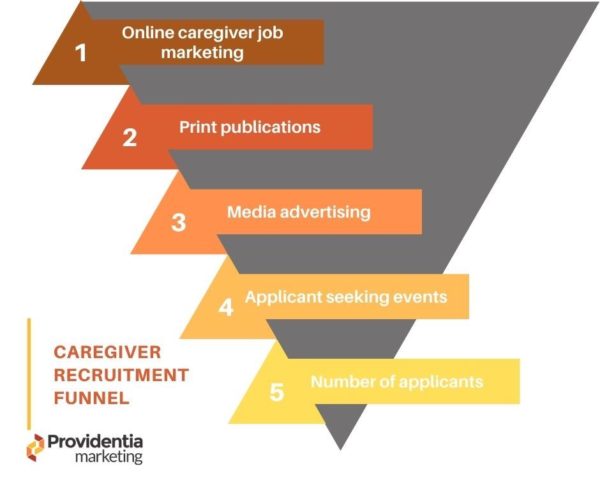
The above funnel is a baseline of marketing data. From a marketing perspective, working on a recruitment process means creating a funnel and adding levels for analyzing numbers.
The percentages for each item track marketing effectiveness and narrow down areas that need improvement. Using marketing for recruiting caregivers saves time, money and helps find long-term, high-quality caregivers.
The Digital Edge - In a Digital Age
Digital marketing is today's preferred marketing channel for almost all recognizable brands and companies. Advertising campaigns deliver product information through digital channels such as website SEO, search engine optimization, social media, email, mobile apps, and even simple methods like texting.
The digital age arrived years ago, and according to Pew Research, "85% of Americans say they go online on a daily basis." Of this percentage, 31% of Americans report being online almost continuously. Americans who go online several times a day equals 48%, of which 6% reported frequently going online every day. Only 8% of Americans said they're online several times a week or less, and 7% of American adults reported they do not use the internet at all. Of these numbers, almost 70% of internet users are on cell phones.
With the number of people online and on their devices, digital marketing is not only beneficial for product sales; it's a digital edge the home care industry needs to adopt at a greater level.
Simple Digital Marketing Techniques That Are Easy to Implement
There are numerous digital marketing techniques for recruiting job candidates based on the industry and geographical location. Posting jobs and implementing caregiver recruitment processes can be costly. To save advertising money, caregiver agencies can target their efforts to areas based on where candidates live rather than where their clients are.
The following marketing practices help to streamline caregiver recruitment and create a cost-effective hiring campaign. Remember to perform periodic checks on the success of your campaigns.
- Run ads and campaigns where possible caregiver recruits live
- Target website SEO for caregiver job keyword search statistics
- Use Google Ads
- Make use of job seeker sites, such as Indeed, Craig's List, ZipRecruiter and myCNAjobs.com
- Create website pages targeted at potential recruits (more about this in chapter 4)
- Make use of social networking channels (more about this in chapter 6)
- Enlist texting to communicate with applicants
The digital edge for the home care industry is to embrace the digital age and convert marketing processes for caregiver recruitment using technology. Advertising positions, recruit outreach, and attracting caregiver prospects through digital means increase a home care agency's reach and caregiver recruitment success.
Your Website: Make Your Company Shine
A home care agency's first impression for caregiver prospects is typically their website. There are two main areas to look at when optimizing your website to attract caregiver candidates.
The first area is ensuring your website is easy to find and sits at the top of Google search result pages. The second area involves website content and design. Your content should make your company shine, incorporating the climate prospects can anticipate working in.
Optimizing Your Website for Best Exposure
There are quite a few areas where a website can garner the best search results. For a home care agency looking for caregivers, some of the top concerns are incorporating search engine optimization (SEO) keywords targeting localized searches.
Caregivers search for jobs in the area where they live. Prospects will use keywords for home care agencies including the name of the city, county, or town name. Other keyword samples include search terms such as in-home care services, home health care services, caregiver jobs, care agencies. Having a blog is another great way to include keywords through blog posts relevant to caregivers.
Additional website considerations include being mobile-friendly. In a 2020 Dataportal report, mobile phone use makes up 50 percent of users' time on the internet. With this in mind, your website should be mobile-friendly, including your application process.
Creating Career Content on Your Website
Create a section of your home care agency's website dedicated to career pages. Keeping all the information and application process in one section of your website allows prospects to have seamless access to your caregiver position details, mission statement, and other pertinent information.
According to CareerPlug's 2021 Benchmark Data Recruiting Metrics, "…An applicant who applied directly from a company careers page was 7 times more likely to be hired than an applicant from a job board." By providing an outstanding candidate experience, your website promotes the character and professionalism of your agency.
The career section of your website should include the following information and pages:
- The home care agency's mission statement
- Reviews and feedback from past and current employees
- A concise but detailed caregiver job description (although this may be clear for some, including this description, assures applicants your agency knows what the duties of a caregiver are)
- Contact information on each page, including a telephone number, agency location, and direct email for human resources
- An FAQ targeted to caregivers working for your agency
- Easy to locate shareable options for all your social networking sites
Your website will attract top talent applicants by highlighting the knowledge and expertise of your home care agency making caregiver recruitment productive and cost-saving.
Speak to Your Audience: Define the Mission of Your Home Care Agency
Today's caregiver prospects want to know more about a home care agency's values and company culture. Demonstrating your agency is diverse, engaged and sharing your brand's story encourages candidates to be part of the bigger goal. Having a strong mission statement defines the nature of your agency and how it treats its employees and clients.
The Makings of a Home Care Agency Mission Statement
A home care agency mission statement includes a summation of the agency's values, goals, purpose, and vision for the future. Your mission statement needs to express the story of your particular agency and passes along the "We love what we do," message. A caregiver agency's powerful mission statement can add purpose and vision to the caregivers it employs.
Sample Information for a Home Care Agency Mission Statement
- Provide a short story of the agency's origins
- Who are the clients, and what does the agency want to do for them?
- Describe your home care agency goals
- List the agency's values
- How do you see the agency evolving?
- Detail the mile markers the agency has already accomplished
- Describe additional mile markers the agency is working towards
A mission statement should include goals that are specific, achievable, measurable, and client-oriented. Wording it to appeal to caregivers helps prospective candidates see themselves as a valuable part of your organization.
Millennials and the Caregiver Workforce
According to Pew Research, 35% of the American workforce are Millennials ages 23 to 38. Millennials love the sense of fulfillment in their job and look for work where they can have connections with others working towards the greater good. Presenting your agency's mission statement to make a difference in each client's life anchors your goals into Millennial ideology.
Older Millennials may have experience taking care of more senior family members or are already caring for elderly loved ones at home. With adaptable and innovative skills, Millennials want to be part of implementing procedures and strategies to develop better ways to serve the home care industry.
Allow your mission statement to send the message to prospective caregivers that you are on top of the changing climate of in-home care and recognize the digital and social changes happening now and in the future. Younger, bright minds have the technology and collaborative skills to make a difference in the evolving home care industry.
Use Social Media to Connect, Inform and Recruit
While a home care agency can post on job boards such as Indeed and Monster, many candidates are scrolling through social media accounts daily. Forbes reports that "73 percent of job seekers between the ages of 18 and 34 found their last job on social media." Using your agency's Facebook page to share links to your career pages can attract some of the best talent in the home care industry.
As the previous chapter discussed, Millennials make up a large part of the U.S. workforce. And Millennials are on social media. Social media has grown from strictly fun to a valid business marketing platform.
The two leading platforms that provide robust marketing are Facebook and Instagram. Facebook owns Instagram, and both integrate tools and analytics for businesses to use as part of their digital marketing plan. On Statista.com, the most used social media sites as of July 2021 are:
- YouTube
- Facebook Messenger
Facebook is the parent organization for WhatsApp, Instagram, and Facebook Messenger. Considering the business relationship of Facebook and Instagram, the two platforms stand out as the most successful social media resources for caregiver recruitment.
Social Media Caregiver Recruitment Best Practices
- Post on a regular and consistent schedule
- Choose meaningful, engaging content and be sure to respond to comments and messages
- Post informative photos and videos about subjects concerning caregivers
- Share spotlights of the home care agency's caregivers
- Post video testimonies from current agency caregivers
Using Facebook
Home care agencies can take advantage of Facebook's free Business Manager. Facebook Business Manager allows for creating separate ad accounts to create, pay for with different payment methods and keep track of particular ads. Reports contained within Business Manager present an analysis of the ad's performance and how much engagement they attract.
Facebook Ads Manager is a subset of Business Manager where you create and monitor your ads. Home care agencies can set the location for ads to target caregivers in their area.
Using Instagram
Establishing your Instagram business account includes posting lots of photos and videos relating to your agency and the home care industry.
As with Facebook posts, integrate job listings with relative memes, quotes, caregiver information, and employee highlights. Hashtags and tagging create a much further reach. Use them consistently, keeping with terms related to caregiving.
Encourage users to tag friends who may be interested in caregiver jobs, rewarding the efforts with gift cards or other prizes. All these interactions increase engagement and followers, translating to job post visibility for caregiver job applicants.
Streamline Your Application Process
Potential caretaker hires view your agency’s job listing first. An immediate impression of your business comes from how the posting reads and what information is included. The priority is to create a listing to weed out unwanted candidates but not turn away qualified recruits.
The tone of your ad will relate to some people and not others. Sharing part of your agency’s mission statement and expressing the concern that clients receive exceptional care could discourage less motivated workers. Qualified candidates who care about what they do will continue with the application.
Job Descriptions
At times, applicants will apply to an agency’s job opening without understanding the duties of an in-home caregiver. Job descriptions that include what your agency expects from the candidate should also include what a caregiver does, information on scheduling, training opportunities, incentive programs, or any other employee benefits offered. Applicants who may need certain job benefits will not apply, but the right applicant will.
Locations, Salary, and Travel
Always include location profiles for each job listing so applicants can determine if it’s within their travel distance limitation.
Completing an application process and then finding out the new employee does not want to travel to the area you’ve hired them for means wasted time going through the entire hiring process.
Clearly list the salary you are offering so there won’t be discrepancies later about the pay scale. Any discussion about expected salary and actual salary is typically a deal-breaker for new recruits.
Communication
Any job applicant wants to feel recognized, heard, and important. Communication at every stage of the recruitment process means you develop a repertoire that propagates an employer/employee relationship.
Timing
Caregiver applicants are more likely to complete the application process and eventually be hired when encountering a thorough but streamlined process.
Home care agencies should be aware that applicants are likely applying for several jobs at the same time. Employers who respond first can move their recruitment process along faster.
The Interview
With the critical need for more caregivers, hiring agencies may shorten their interview process. A good interview leaves time for both the agency and the candidate to ask questions and clarify any confusion about the position. During this time, both candidate and employer interact and get a feel for whether each is a good fit.
Keep Track of Applications, Applicants, and Sources
When juggling caregiver applications, there are many facets included with the recruitment process. Keeping track of all the different areas and ultimately hiring a quality caregiver candidate can prove challenging.
If a home care agency is using multiple apps and software to record and analyze data, top caregiver hires may get lost in the shuffle while less-desired candidates get hired. The expense is increased, and often, your agency’s reputation for providing outstanding caregiver services to your clients is affected.
An applicant tracking system (ATS), which is usually cloud-based, provides one place to manage each part of the caregiver hiring process and simplifies the hiring process.
ATS Software Benefits
ATS helps home care agencies to optimize caregiver recruitment and hiring in various ways, including:
- Creates a system of checks to filter out unqualified caregiver applicants
- Facilitates quick and accurate communication with applicants
- Provides one location to manage information and metrics for all candidates
- Filters data to identify the best candidates
- Speeds up the caregiver recruitment process without compromising quality
- Provides background checks to streamline screening
- Allows an efficient hiring operation so agencies can spend more time on employee onboarding
In order to keep your caregiver recruitment process economical, ATS software provides detailed analytics throughout the entire hiring process. As in the marketing funnel methodology, ATS software pinpoints areas that need refining to create more cost-effective caregiver recruitment.
Cautions of ATS
There are some flaws when using ATS software platforms. It’s good to be aware that the increased efficiency of caregiver recruitment may also turn away premium candidates. For example, if you require CPR certification and a highly qualified candidate does not have this training, ATS software may remove them from the funnel.
One option is to limit the number of qualifications required, so you can screen employees yourself and decide to hire or not. Qualities such as compassion, integrity, passion for their work, and a strong work ethic typically prove to be more valuable than a certification that can be obtained after hire.
Improve Your Interview and Onboarding Process
During an interview with a caregiver candidate, it’s helpful to allow the prospective hire to feel at ease. Chatting a bit, asking about their day, and sharing something about yourself creates a connection, so they feel comfortable. Still, an interview does not allow enough time to get to know the caregiver well. That’s where onboarding comes in.
New employees going through onboarding not only become familiar with their new employer, but they are also introduced to the organization’s culture, expectations, and, when done right, the agency’s mission statement precedents.
Key Characteristics of a Successful Caregiver Onboarding
Make use of ATS - An ATS system can automate paperwork and send additional forms such as I-9 and W-4 forms ahead of time, so the new caregiver does not have to spend their first day filling out piles of paperwork.
Keep it engaging - A boring onboarding will cause new caregivers to lose interest. Be sure to include the new hire in hands-on examples of job duties and ask for their feedback on the agency’s expectations. Treat them with respect and promote a team atmosphere.
Be consistent - While each caregiver may have varying duties that apply to their particular client load, every new caregiver should have the same agency expectations and policies to follow.
Be welcoming to the new caregiver - Onboarding is a great time to welcome your new caregiver and make them feel they’re part of the team. Highlight them on the agency’s social networking and have other team members text them a welcome message or send them an email.
Create a 30/60/90 day plan - Establish goals for the employee and agency that will be revisited at 30, 60, and 90 days to keep everyone on track.
Onboarding sets the one for new caregivers and goes far in establishing an agency/caregiver relationship. First impressions do matter and work well to avoid conflict after hire. According to an article by the Society for Human Resource Management, titled “Don’t Underestimate the Importance of Good Onboarding,”
- “69 percent of employees are more likely to stay with a company for three years if they experienced great onboarding.
- “New employees who went through a structured onboarding program were 58 percent more likely to be with the organization after three years.
- “Organizations with a standard onboarding process experience 50 percent greater new-hire productivity.”
Create a Referral Program
Building a successful referral program opens up a tremendous resource of talented caregivers. An agency’s highly regarded caregivers tend to refer peers who are as skilled as they are.
A caregiver referral program is one of the most economical ways to increase your caretaker pool. The most efficient way to run a referral program is to keep it organized, track results and costs, and use it consistently.
A well-run employee referral program provides the following benefits
- Increases your pool of new caregivers
- Opens up channels to hire capable caregivers for client satisfaction
- Reduces turnover by finding loyal caregivers
- Allows a connection to management promoting employee satisfaction
- Saves time and hiring costs
- Increases morale by hiring caregivers who have an existing relationship
Incentives for Referral Programs
A referral program needs to be sustainable. Knowing the average cost of caregiver acquisition allows you to gauge the referral program rewards. Existing caregiver incentives are easier to manage, knowing the average cost to hire from your website or a job board.
When using a referral program at a local job fair, a speaking event, caregiver training, or conference, the costs are higher and need to be factored into the referral incentive.
Referral programs are commonly organized so that the referral bonus does not exceed the cost of onboarding a new caregiver. Before establishing a referral program, quantify the value of hiring referred caregivers and set the award at a reasonable level.
Referred employees often cost less to hire and stay with the agency longer. A well-established referral program creates a maximum return on investment.
Presenting a Referral Program to Existing Employees
When establishing your referral program, be sure to document and communicate the details and awards to all active caregiver employees, so they understand the expectations and results. Share this information in a group setting and then follow up with reminder emails, include the details in monthly newsletters, and utilize in-person follow-ups.
As an ongoing thank you for employees who refer caregivers, add additional rewards. Let your caregivers know you appreciate their efforts by giving them a gift card, company T-shirt, reusable water bottle, or other personalized thank-you items.
Whichever reward system your agency uses, be sure to pay right away. Delaying payment or causing an employee to ask about their incentive degrades the integrity of your referral program and discourages existing caregivers from participating.
Need Help With Caregiver Recruitment?
As you can see, there are a lot of moving parts when it comes to an effective recruiting strategy and it may seem overwhelming. If you want to make it easier, contact the recruitment experts at Home Care Marketing Pros! We're well versed in SEO, social media, job boards, and other avenues of recruitment. We'd love to help you succeed!

